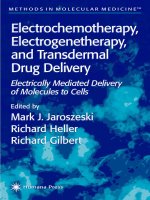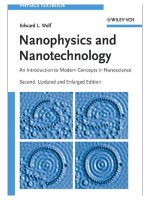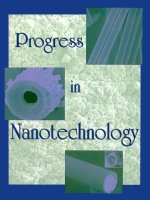- Trang chủ >>
- Khoa Học Tự Nhiên >>
- Vật lý
nanotherapeutics. drug delivery concepts in nanoscience, 2009, p.293
Bạn đang xem bản rút gọn của tài liệu. Xem và tải ngay bản đầy đủ của tài liệu tại đây (19.24 MB, 293 trang )
NANOTHERAPEUTICS
Drug
Delivery Concepts
in
Nanoscience
This page intentionally left blankThis page intentionally left blank
NANOTHERAPEUTICS
Drug Delivery Concepts
in Nanoscience
edited
by
Alf
Lamprecht
of
France
PAN STANFORD PUBLISHING
Published by
Pan Stanford Publishing Pte. Ltd.
5 Toh Tuck Link
Singapore 596224
Distributed by
World Scientific Publishing Co. Pte. Ltd.
5 Toh Tuck Link, Singapore 596224
USA
office:
27
Warren Street, Suite 401-402, Hackensack, NJ 07601
UK
office: 57 Shelton Street, Covent Garden, London WC2H 9HE
British Library Cataloguing-in-Publication Data
A catalogue record for this book
is
available from the British Library.
NANOTHERAPEUTICS
Drug Delivery Concepts in Nanoscience
Copyright
© 2009 by Pan Stanford Publishing Pte. Ltd.
All rights reserved. This book, or parts thereof, may not be reproduced
in
any form or by any means,
electronic or mechanical, including photocopying, recording
or
any information storage and retrieval
system now known
or
to be invented, without written permission from the Publisher.
For photocopying
of
material in this volume, please pay a copying fee through the Copyright
Clearance Center, Inc., 222 Rosewood Drive, Danvers,
MA
01923, USA.
In
this case permission to
photocopy is not required from the publisher.
ISBN-13 978-981-4241-02-1
ISBN-IO 981-4241-02-4
Printed in Singapore by Mainland Press
Pte
Ltd
In
memoriam Armin Lamprecht
This page intentionally left blankThis page intentionally left blank
Preface
Research and development
of
innovative drug delivery systems are
increasing at a rapid pace throughout the world. This trend will intensify
in future
as
public health expenses demand lower costs and increased
efficiency for new therapies. In order to meet this demand, many well-
known and efficiently applied drugs will be reformulated in new drug
delivery systems that can be value-added for optimized therapeutic
activity.
One important aspect in the newly developing field
of
nanomedicine
is the use
of
nanoparticule drug delivery systems allowing innovative
therapeutic approaches. Nanotechnology
as
a delivery platform offers
very promising applications in drug delivery. Due to their small size such
drug delivery systems are promising tools in therapeutic approaches such
as
selective or targeted drug delivery towards a specific tissue or organ,
enhanced drug transport across biological barriers (leading to an
increased bioavailability
of
the entrapped drug) or intracellular drug
delivery which
is
interesting in gene and cancer therapy.
The nanotechnological approaches in drug delivery include a large
variety of forms, mainly systems based on lipid or polymeric
nanoparticles (nanocapsules and nanospheres) microemulsions,
liposomes, but also polymeric micelles and cyclodextrins.
Potentially
different from other scientific communities in the field
of
drug delivery,
nanoparticulates are defined
as
carrier system with a size below one
micron.
On behalf
of
a great team
of
nano researchers who have been part
of
this exciting project, I am pleased to introduce to the scientific
community a comprehensive work on Nanotechnology applied in the
Vll
Vlll
Preface
field
of
drug delivery, which can be seen
as
a knowledge base for
therapeutic applications
of
nanotechnologies.
In
the past decade, ongoing efforts have been made to develop
systems or drug carriers capable
of
delivering the active molecules
specifically to the intended target organ in order to increase the
therapeutic efficacy. This approach involves modifying the
pharmacokinetic profil
of
various therapeutic classes
of
drugs through
their incorporation in colloidal nanoparticulate carriers in the submicron
size range such
as
liposomes or nanoparticles. These site-specific
delivery systems allow an effective drug concentration to be maintained
for a longer interval the target tissue and result in decreased side effects
associated with lower plasma concentrations m the peripheral blood.
Thus, the principle
of
drug targeted is to reduce the total amount of drug
administered while optimizing its activity.
It
should be mentioned that
the scientific community is still skeptical that such goals could be
achieved since huge investments
of
funds and promising research studies
have in many cases resulted in disappointing results and have also been
slow in yielding successfully marketed therapeutic nanocarriers. With the
recent approval by health authorities
of
several effective nanosized
products containing antifungal or cytotoxic drugs, interest in small drug
carriers has been renewed.
A vast number
of
studies and reviews
as
well
as
several books have
been devoted to the development, characterization, and potential
applications
of
specific microparticulate- and nanoparticulate delivery
systems. No encapsulation process developed to date has been able to
produce the full range
of
capsules desired by potential capsule users. Few
attempts have been made to present and discuss in a single book the
entire therapeutic range
of
nanocarriers covered in this book. The general
theme and purpose here are to provide the reader with a current and
general overview
of
the existing nanosized delivery systems and to
emphasize the various fields
of
therapeutic applications. The systematic
approach used in presenting the first part introducing to the general
therapeutic options followed by disease-focused reviewing the existing
drug carriers should facilitate the comprehension
of
this increasingly
complex field and clarify the main considerations involved in designing
Preface
IX
manufacturing, characterizing, and evaluating a specific nanosized-
delivery system for a given therapeutic application or purpose.
The first part highlights the exceptional properties
of
nanoparticles
involving their sustained drug release and other physicochemical
properties, but especially their ability to trigger drug transport across
biological barriers. The general mechanisms
of
drug delivery, particle
translocation, interactions with cells are detailed in this part
of
the book.
Besides, the general strategies of nanoparticulate drug targeting and gene
therapy will be elucidated here. The first part
of
the book starts with a
chapter describing the physicochemical aspects
of
nanocarriers,
including particulate systems, liposomes, micellar systems, emulsions,
their principal properties, the main excipients necessary for their
manufacturing and the basics on their preparation techniques. The
authors also address major issues such
as
the stability
of
these
formulations
as
well
as
aspects on the final pharmaceutical form to
administer these carriers.
The following chapters deal with the general aspects on drug
transport across biological barriers, for the moment one
of
the most
important applications of nanocarriers in the field
of
therapeutics. Drugs
with low permeability properties can significantly enhance their value by
their use in a nano-formulation which increases its transport.
Another important aspect is the application
of
small carriers in the
area
of
drug targeting. This chapter elucidates the potential of
nanocarriers in order to allow specific drug delivery to inaccessible
disease sites.
The last chapter in this first part is presenting the application
of
nanodevices in the field
of
the gene therapy. Although still today most
of
the gene therapy approaches rely on the use
of
viral systems, more and
more studies deal with the use
of
non-viral gene delivery due to the
advances in the development
of
biomaterials.
The second part will focus specifically on the therapeutic approaches
which are possible by the use
of
nanocarriers dividing the overall context
into chapters dealing with diverse diseases and the relevant therapeutic
approaches based on the design
of
nanoparticulate drug delivery systems.
I am very grateful to all the authors who have shared
my
enthusiasm
and vision by contributing high quality manuscripts, on time, keeping in
x
Preface
tune with the original design and theme
of
this work. You will not be
having this book in your hand less their dedication and sacrifice.
Editor
Alf
Lamprecht
University
of
Franche-Comte, France
2007
CONTENTS
Dedication
Preface
Part
I:
General Aspects
of
Nanotherapeutics
Chapter 1
References
Nanocarriers in Drug Delivery - Design, Manufacture
and Physicochemical Properties
Christoph Schmidt and
Alf
Lamprecht .
Chapter 2 Transport Across Biological Barriers
Noha Nafee, Vivekanand Bhardwaj and Marc Schneider .
References
Chapter 3 Targeting Approaches
Sandrine Cammas-Marion .
References
v
vii
3
30
39
56
67
86
Part II: Disease-Related Approaches by Nanotherapeutics
91
Chapter 4 Nanoscale Cancer Therapeutics
Yann Pellequer and
Alf
Lamprecht 93
References 116
Chapter 5 Nanotherapeutics for Skin Diseases
Nicolas Atrux-Tallau,
Franr;;oise
FaIson and Fabrice Pirat 125
References 153
xi
xii
Contents
Chapter 6 NanoparticIes for Oral Vaccination
Juan
M.
Irache, Hesham
H.
Salman, Sara Gomez
and
Carlos Gamazo 163
References
Chapter 7 NanoparticIes: Therapeutic Approaches for Bacterial
Diseases
189
Brice Moulari 199
References
Chapter 8 NanoparticIe Therapy in Parasites Diseases: Possibility
and Reality!
220
Malika Larabi 227
References 253
Chapter 9 Nanocarriers in the Therapy
of
Inflammatory Disease
Aif
Lamprecht 261
References 273
Index
277
Part
I
GENERAL
ASPEGTS
OF
NANOTHERAPEUTIGS
This page intentionally left blankThis page intentionally left blank
NANOCARRIERS
IN
DRUG
DELIVERY-
DESIGN,
MANUFACTURE
AND
PHYSICOCHEMICAL
PROPERTIES
Christoph Schmidt
Biogen Idec International GmbH,
Small Molecule Development International,
Zug (Switzerland)
Alf
Lamprecht
Laboratory
of
Pharmaceutical Engineering,
Faculty
of
Medicine
and
Pharmacy, University
of
Franche-Comte,
Besan(lon (France)
4 Nanotherapeutics Drug Delivery Concepts
in
Nanoscience
1.
Introduction
Colloidal dispersions comprise particles or droplets in the submicron
range
«
l)lm
Figure
1)
in an aqueous suspension or emulsion,
respectively. This small size
of
the inner phase gives such a system
unique properties in terms
of
appearance and application. The particles
are too small for sedimentation, they are held in suspension by Brownian
motion
of
the water molecules. They have a large overall surface area
and their dispersions provide a high solid content at low viscosity.
The constituents
of
nanoparticles for biomedical application need to
be physiologically compatible (biocompatible), and they need to be
biodegradable (disintegrating in physiological environment) to
physiologically harmless components or to have the ability to be excreted
via kidney or bile.
Fig. 1 Scanning electron microscopic image
of
nanoparticles.
Nanoparticles are carriers for conventional drugs
as
well
as
for
peptides and proteins, enzymes, vaccines, or antigens. According to the
process used for the preparation
of
nanoparticles, nanospheres or
Nanocarriers in Drug Delivery
5
nanocapsules can be obtained. Nanospheres or nanoparticles are
homogeneous matrix systems in which the drug is dispersed throughout
the particles, whereas nanocapsules are vesicular systems in which the
drug is confined to a cavity surrounded by a polymeric membrane
(Figure 2).
a)
b)
Fig. 2 Schematic representation
of
a)
nanospheres, drug homogeneously distributed
within the matrix, and b) nanocapsules, drug-core surrounded by shell.
Nanocarriers for pharmaceutical use can be
of
polymeric nature or
consist
of
lipophilic components plus surfactants, i.e., liposomes,
niosomes, and solid lipid nanoparticles.
Other materials investigated for
nanoparticle preparation are albumin [Kreuter, 1994], gelatin [Kreuter,
1994], or calcium alginate [Rajaonarivony
et ai., 1993]. There are also
methods available to size-reduce drug substances into the nanometer
range, with the resulting particles being stabilized by surfactants.
Initially, colloidal drug delivery systems have been developed for the
intravenous (i.v.) administration
of
drugs with the goal to improve their
therapeutic efficacy through principles like controlled drug release,
targeted drug delivery, or prolongation
of
the circulation time [Kreuter,
1994]. Besides the i.v. route, colloidal particles have also been
administered orally, either for systemic uptake or local activity within the
gastrointestinal tract [Chen and Langer, 1998;
Damge et ai., 1987; Kim
et ai., 1997; Kreuter, 1991, 1994; Maincent et ai., 1986].
In
addition,
such carrier systems have been developed and tested for almost all routes
of
administration, for local application on skin and mucosa as well as for
systemic use by parenteral application or by inhalation.
This chapter will present an overview over the most prominent
examples
of
colloidal carriers, their different general characteristics,
some insights to the preparation
of
such carriers, as well
as
describing
some details on the physicochemical properties of the diverse systems.
6 Nanotherapeutics - Drug Delivery Concepts
in
Nanoscience
2.
Manufacturing of Nanoparticulate Systems
Depending on the nature
of
the starting material and the intended use
of
the nanoparticulate system to be prepared, a variety
of
technologies has
been developed and is available for developing and manufacturing
colloidal systems. The following overview provides some background
information, the most common methods for drugs to be encapsulated and
the most important mechanisms
of
nanoparticle formation from a
physicochemical point
of
view. Various methods have been developed
for preparing nanoparticle dispersions
as
they are established in
industries like coating or plastics. However, the application to
pharmaceutical systems containing drugs imposes a number
of
constraints in selecting the materials, for the size of the particles to be
prepared, and for the process itself to prevent e.g. drug degradation.
Thus, the methods developed in other disciplines have accordingly been
adapted to meet these requirements.
2.1. Nanosized Drug Substance
Direct nanosizing
of
drugs,
as
reviewed by Merisko-Liversidge et
al.
[2003] provides for delivery
of
poorly water-soluble drugs to enhance
their solubility. Micron-size drug particles are milled in a water-based
stabilizer solution for
30-60 minutes to generate nanoparticles with
unimodal size distribution. The amount
of
the suspension stabilizer is
critical since too little
of
it is unable to prevent aggregation
of
small
particles, and too much
of
it may accelerate particle growth by Ostwald
ripening.
Since drug dissolution is directly dependant on the surface area,
this approach
of
increasing the specific surface area might be useful for
formulation
of
drugs with a low solubility in aqueous environments.
"Milling"
as
described above in this context includes processes
as
conducted in ball- or pearl-mills for a longer time [Liversidge et aI.,
1992]. Size reduction is obtained by milling pearls made
of
steel, glass,
zircon dioxide, or polymers such
as
hard polystyrene. Other milling
techniques use rotor-stator colloid mills, or
jet
mills where particles are
accelerated and break upon impaction on either another particle or a wall.
Nanocarriers
in
Drug Delivery 7
High-pressure homogenization, where a suspension
of
a drug is pressed
through a small cavity, is also applied for size reduction
of
drug particles
by shear and impact forces [Muller
et aI., 2006].
Several other methods have been described in the literature such
as
the use
of
supercritical fluid technologies principally leading to particles
in the size range
of
100 to 500 nm for griseofulvin [Chattopadhyay et at.,
2001] or rifampicin [Reverchon et at., 2002]. With supercritical fluids
like carbon dioxide, particle formation can be controlled by modifying
the pressure which governs solubility
of
the drugs therein. High pressure
generally provides for higher drug solubility, so that upon reduction
of
the pressure the drug precipitates [Gupta, 2006]. The higher the drop in
pressure is, the faster precipitation occurs and in consequence the smaller
the resulting particles become. Spraying a solution
of
drug (alternatively
of
drug and polymer) in highly compressed supercritical fluid into
atmospheric conditions, rapid expansion of this supercritical solution
takes place. Instead
of
supercritical CO
2
,
organic solvents can be used
spray-drying a solution. However, their handling and processing
precautions need to be taken into consideration.
Another method to prepare amorphous nanoparticle suspension of
poorly water-soluble drugs like Cyclosporine A
IS
evaporative
precipitation into aqueous solution. Rapid evaporation
of
a heated
organic solution of the drug
is
followed by its atomization into aqueous
solution. This is leads to a nanoparticle suspension, which can be dried to
produce oral dosage forms with low crystallinity and small particle size
[Chen
et at., 2002].
The aerosol flow reactor method [Eerikainen et aI., 2003] involves
first dissolving the drug material in question in a suitable solvent, which
is
then followed by atomizing the solution
as
fine droplets into a carrier
gas. A heated laminar flow reactor tube is used to evaporate the solvent,
leaving behind spherical smooth solid drug nanoparticles. The particle
diameter increased with increasing reactor temperatures (up to
160°C)
due to formation
of
hollow nanoparticles.
Finally, a high gravity reactive precipitation technique was used to
prepare nanoparticles
as
fine
as
10 nm. The feasibility
of
preparing
nanoparticles of organic pharmaceuticals was carried out in rotating
8
Nanotherapeutics - Drug Delivery Concepts in Nanoscience
packed bed under high gravity. The formation
of
ultrafine particles was
due to intensified micro-mixing
of
reactants in the rotating bed to
enhance nucleation while suppressing crystal growth [Chen
et al., 2004].
2.2. Polymeric Nanoparticles
The majority
of
pharmaceutical nanoparticles are a combination of the
active substance with polymeric exclplents. Drug-containing
nanoparticles can be obtained through the incorporation
of
a drug
substance during or after the preparation
of
a polymer dispersion. The
active components are dissolved, entrapped (in which cases the colloidal
particles are often referred to
as
nanocapsules), or adsorbed to the surface
of
the nanoparticles. Also, combinations
of
these arrangements are
possible.
For preparation
of
polymeric nanoparticle dispersions two ways are
very common.
One is to polymerize the respective monomers in an
emulsion or in a micellar system, leading to a system referred to
as
'latex'. Such nanoparticlulates are obtained by inducing the reaction
of
monomers to form the polymeric carrier. The second principal method
bases on preparation
of
nanoparticles using preformed polymers. The
latter approach
is
in general similar to those applied for generating
nanosized drug particles,
as
described above.
2.2.
1.
Nanoparticles Prepared
by
Polymerization
Related to the manufacture of latices found in polymer chemistry,
methods were adapted from other industrial techniques available for
obtaining artificial latexes.
Generally, monomers and suitable catalytic agents are dissolved in an
aqueous system comprising either emulsified lipophilic droplets or
micelles. At the interface between aqueous and non-aqueous phase or at
the surfactant layer
of
the micelles, respectively, the monomers react
with each other leading to oligomers and later polymers. These
concentrate in the non-aqueous phase, forming initially soft and semi-
solid, subsequently solid particles. Such reactions can occur
spontaneously or can be triggered by physical means such
as
heat or
Nanocarriers
in
Drug Delivery
9
irradiation. The reaction usually continues
as
long
as
further monomers
are available or, in some cases,
as
long
as
reactive groups are present
within the polymeric particles. Thus, reactions are terminated by
controlling monomer supply or reaction conditions such
as
temperature,
pH, concentration of reactants, or the like. The drug to be entrapped in
nanoparticles generated by polymerization is dispersed in either the
aqueous phase or in the organic or micellar part, depending on their
solubility properties
as
well
as
on their susceptibility to interaction with
the mono- and oligomers [Speiser, 1998].
However, polymeric nanoparticles prepared by emulsion
polymerization may encounter some drawbacks. With the exception
of
alkylcyanoacrylate, most
of
the monomers suitable for a micellar
polymerization in an aqueous system lead to polymers slowly or not
biodegradable. The polymerization process is mainly limited to the vinyl
addition reaction, and the molecular weight of the polymeric material
cannot be fully controlled. Residues in the polymerization medium (e.g.
monomers, oligomers, organic solvents, surfactant, or catalyzing agents)
can be toxic and may necessitate further purification
of
the colloidal
material. During the polymerization process, activated monomer
molecules also may interact with the drug molecules, potentially leading
to their inactivation or modification [Grangier
et
aI., 1991].
Nonetheless, emulsion polymerization is a very popular approach
used to synthesize polymer colloids with a matrix structure. This process
for polymerization
of
polyalkylcyanoacrylates was introduced by
Couvreur
et
aI.
[1979] to design biodegradable nanoparticles for the
delivery
of
drugs with various physico-chenlical properties.
Methods based on interfacial polymerization have been developed to
prepare nanocapsules consisting
of
a liquid core surrounded by a thin
polymer envelope
[AI
Khoury-Fallouh et al., 1986]. The reactions are
performed either in water-in-oil or in oil-in-water emulsion systems, or
in microemulsions, leading to the production
of
water- or oil-containing
nanocapsules, respectively.
Oil-containing nanocapsules are obtained by
the polymerization of alkylcyanoacrylates at the oil/water interface of a
very fine oil-in-water emulsion
[AI
Khoury-Fallouh et aI., 1986]. Water-
contammg nanocapsules may be obtained by the interfacial
polymerization
of
alkylcyanoacrylate in water-in-oil microemulsions.
In
10
Nanotherapeutics - Drug Delivery Concepts
in
Nanoscience
these systems, water-swollen micelles of surfactants
of
small and
uniform size are dispersed in an organic phase. The monomer is added to
the microemulsion and polymerizes at the surface
of
the micelles. The
polymer forms locally at the water-oil interface and precipitates to
produce the nanocapsule shell [Gasco and Trotta, 1986].
2.2.2. Nanoparticles Prepared
by
Preformed Polymers
Beside the already mentioned toxicological aspects, not many polymeric
materials are capable
of
being prepared by emulsion polymerization,
examples are polyurethane, epoxyethers, polyester, and others, including
semi-synthetic polymers such
as
cellulose derivatives. Such materials
remain unavailable for aqueous dispersion. In order to overcome some
of
these limitations, nanoparticle preparation methods using various
preformed macromolecular materials have been developed. The
physicochemical and biological properties of the polymers formed by
conventional polymeric synthesis pathways can be well controlled.
Dispersion formation from such materials leads to so called pseudo-
latices
(=
artificial latices) [Kreuter, 1994]. For drug deli very purposes,
the polymeric material needs to meet physicochemical and biological
needs to have its physicochemical and biological properties adapted and
optimized for their specific application. Most of the synthetic latices
prepared for industrial applications did not meet these requirements, and
various approaches were developed in order to obtain polymeric
nanoparticles fulfilling the pharmaceutical criteria.
The corresponding manufacturing techniques to obtain colloidal
systems generally dissolve the preformed polymer in an organic water-
miscible or -immiscible solvent or in a supercritical fluid, i.e. in a gas
held under high pressure. This solution is emulsified into water, and the
solvent is evaporated or controlled desolvation is applied. To obtain
particles in the nanometer range, it is essential to decrease the droplets
of
the emulsion to the desired size. High shear equipment is employed,
using e.g., high pressure homogenization [Gurny
et
ai., 1981], sonication
[Krause
et
aZ.,
1985], or micro fluidization [Bodmeier and Chen, 1990].
The methods
of
preparing pharmaceutical nanoparticles aim at
processing different water-insoluble polymeric materials, they are rarely
Nanocarriers
in
Drug Delivery
11
specific
to
certain polymers. Almost all
of
the industrial techniques for
obtaining artificial latexes rely on one of the following processes:
2.2.2.1 Emulsion-Solvent Evaporation
Polymer and drug are dissolved in a suitable volatile solvent which is
immiscible with water. This solution is emulsified in an aqueous solution
containing stabilizer (mostly surfactants) by conventional emulsification
techniques. Droplet size can be further reduced by using a high-energy
source. Continuous emulsification under mixing prevents coalescence
of
organic droplets and allows the spontaneous evaporation
of
the solvent
at room temperature and the formation
of
the colloidal particles.
Following evaporation
of
organic phase under reduced pressure or
vacuum produces a fine aqueous dispersion
of
nanoparticles. These can
be collected by centrifugation, washed to remove residual stabilizer and
can be freeze dried for storage [Quintanar-Guarrero
et al., 1998; Jaiswal
et al., 2004; Song et al., 1997]. As this approach is limited to certain,
mainly water-insoluble drugs, a variation
of
the first method has been
developed for the encapsulation of more hydrophilic drugs. The so-called
double-emulsion-technique is thus very interesting for the entrapment of
peptides, proteins and nucleic acid sequences. Here, water-in-oil-in-water
(w/o/w) emulsions are used, incorporating hydrophilic drugs in an inner
aqueous phase [Vandervoort
et al., 2002]. The polymer is dissolved in
the organic phase and a first mixing step forms a water-in-oil emulsion
which
is
thereafter emulsified in a second, outer aqueous phase. Upon
evaporation
of
the organic phase the polymer precipitates on the surface
of
the inner aqueous droplets, thereby entrapping the drug dissolved
therein.
This technique was principally applied to the preparation of particles
from water insoluble polymers. Since in recent years some interesting
biopharmaceutical properties were observed with highly hydrophilic
polymers, adapted preparation methods were described.
In
contrast to the
prior methods, hydrophilic polymers are dissolved in an aqueous inner
phase and emulsified in a non-miscible apolar liquid, and either the inner
aqueous phase is eliminated under reduced pressure or the polymer was
12
Nanotherapeutics - Drug Delivery Concepts
in
Nanoscience
solidified by a cross-linking reaction [Mitra et ai., 2001]. Solidified
particles are obtained after washing and drying steps.
Control
of
droplet size and size distribution
of
the emulsion are very
important factors in the preparation
of
nanoparticles by these processes.
This warrants reproducibility and quality control especially
if
the process
has to be scaled-up. High pressure homogenizers are capable
of
rapidly
and reproducibly forming emulsions in the required (nano-) size range.
The equipment finds applicability in other methods
of
preparation and is
available from many suppliers, suited for different scales
of
production.
It has been explored by many researchers for producing nanoparticles in
a narrow
SIze
range.
2.2.2.2 Solvent-displacement, -diffusion, or Nanoprecipitation
A solution
of
polymer, drug and lipophilic stabilizer (surfactant)
In
a
semi-polar solvent miscible with water is injected into an aqueous
solution (being a non-solvent or anti solvent for drug and polymer)
containing another stabilizer under moderate stirring. N anoparticles are
formed instantaneously by rapid solvent diffusion and the organic
solvent is removed under reduced pressure [Kumar
et at., 2004]. The
velocity
of
solvent removal and thus nuclei formation is the key to obtain
particles in the nanometer range instead of larger lumps or agglomerates
[Gupta,
2006 a]. As an alternative to liquid organic or aqueous solvents,
supercritical fluids can be applied [Gupta,
2006 b].
Fessi
et
ai.
[1986] proposed a simple and mild method yielding
nanoscale and monodisperse polymeric particles without the use
of
any
preliminary emulsification. Both, solvent and nonsolvent must have low
viscosity and high mixing capacity in all proportions, like e.g. acetone
and water. Another delicate parameter is the composition
of
the
solvent/polymer/water mixture limiting the feasibility
of
nanoparticle
formation. The only complementary operation following the mixing
of
the two phases is to remove the volatile solvent by evaporation under
reduced pressure.
One
of
the most interesting and practical aspect of this methods is its
capacity to be scaled up from laboratory to industrial amounts, since they
can be run with conventional equipment.









